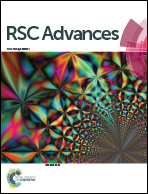Understanding the stereoselectivity in Brønsted acid catalysed Povarov reactions generating cis/trans CF3-substituted tetrahydroquinolines: a DFT study†
Abstract
The Brønsted acid (BA) catalysed Povarov reactions of (E)-1-phenyl-N-(4-(trifluoromethyl)phenyl) methanimine with 1-vinylpyrrolidin-2-one (VPO) and with allyltrimethylsilane (ATMS), affording CF3-substituted cis/trans tetrahydroquinoline (THQ) derivatives, have theoretically been studied using the M06-2X functional together with the standard 6-31G(d) basis set. These BA catalysed Povarov reactions are multistep processes initialised by the nucleophilic attack of the non-substituted carbon atom of the nucleophilic ethylene on the imine carbon atom of the super-electrophilic protonated imine, yielding the corresponding cationic intermediate along the endo/exo stereoisomeric approach mode. Upon the formation of the cationic intermediates, a fast intramolecular Friedel–Crafts reaction converts them into the final THQs and the BA catalyst is recovered as well. For the reaction with VPO, the energetic results indicate that the endo stereoisomeric approach mode is kinetically preferred over the exo one. Interestingly, when the ATMS was experimentally used, the trans THQ resulting from an exo approach mode was the major product. A non-covalent interaction (NCI) analysis of the electron-density of the transition state structures involved in the stereoselective-determining step of these BA catalysed Povarov reactions allows an explanation of the endo/exo stereoselectivity experimentally observed.


 Please wait while we load your content...
Please wait while we load your content...